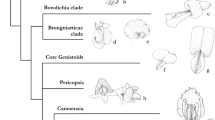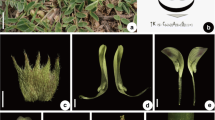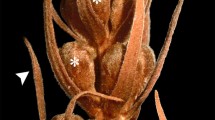Abstract
Inflorescence and floral development of three species of Indigofera (Leguminosae-Papilionoideae), I. lespedezioides, I. spicata, and I. suffruticosa, were investigated and compared with that of other papilionoid groups, especially with members of the recently circumscribed Millettioid clade, which was merged as sister to Indigofereae in a recent cladistic analysis. Although Indigofera is a genus of special interest, because of its great richness in species and its economic importance, few studies have been made of floral development in the genus or in Indigofereae as a whole. Flower buds and inflorescences were analysed at several stages of development in the three species. Our results confirmed that Indigofera species bear a usual inflorescence type among legumes, the raceme, which comprises flowers initiated in acropetal succession, each with a subtending bract and no bracteoles initiated. The inception of the floral organs is as follows: sepals (5), petals (5), carpel (1), outer stamens (5), and, finally, inner stamens (5). Organ initiation in the sepal, petal, and both stamen whorls is unidirectional, from the abaxial side; the carpel cleft is adaxial. The vexillum is larger than other petals at maturity, covering the keels, which are fused edge-to-edge. Nine filaments are fused to form an adaxially open sheath, and the adaxial stamen of the inner whorl remains free (diadelphous androecium) in the mid-stage of development. Most of the infra-generic differences occurred in the later stages of development. Data on floral development in Indigofera obtained here were also compared with those from other members of Papilionoideae. This comparison showed that the early expression of zygomorphy is shared with other members of the Millettioid clade but is rarely found in other papilionoids, corresponding to a hypothetically morphological synapomorphy in the pair Indigoferae plus millettioids.









Similar content being viewed by others
References
Chappill J. A. (1995) Cladistic analysis of the Leguminosae––the development of an explicit phylogenetic hypothesis. Advances in legume systematics. Higher level systematics, Royal Botanic Gardens, Kew, part 7, pp 1–9
Dickison W (1981) The evolutionary relationships of the Leguminosae. In: Polhill RM, Raven PH (eds). Advances in Legume Systematics, Royal Botanic Gardens, Kew. part 1, pp 289–291
Doyle JJ, Chappill JA, Bailey CD, Kajita T (2000) Towards a comprehensive phylogeny of legumes: evidence from rbcL sequences and non-molecular data. In: Herendeen PS, Bruneae A (eds). Advances in legume systematics. Royal Botanic Gardens, Kew, part 9, pp 1–20
Endress PK (1994) Diversity and evolutionary biology of tropical flowers. Cambridge University Press, Cambridge
Foster AS, Gifford EM Jr. (1974) Comparative morphology of vascular plants. 2nd ed. W.H. Freeman and Company, San Francisco
Gerlach G (1969) Botanische Mikrotechnik, eine Einführung. Georg Thieme, Stuttgart
Gerrits PO (1991) The application of glycol methacrylate in histotechnology; some fundamental principles. Department of Anatomy and Embryology, State University Groningen, Netherlands
Goldblatt P. (1981) Cytology and the phylogeny of Leguminosae. In: Polhill RM, Raven PH (eds) Advances in legume systematics. Royal Botanic Gardens, Kew, part 2, pp 427–463
Greyson RI (1994) Inflorescences. In: Greyson RI (ed) The development of flowers. Oxford University Press, Oxford, pp 171–194
Howell GJ, Slater AT, Knox RB (1993) Secondary pollen presentation in Angiosperms and its biological significance. Aust J Plant Sci 41:417–438
Ireland H, Pennington RT, Preston J (2000) Molecular systematics of the Swartzieae. In: Herendeen PS, Bruneau A (eds). Advances in legume systematics. Royal Botanic Gardens, Kew, part 9, pp 217–231
Johansen DA (1940) Plant microtechnique. McGraw–Hill Book Company Inc, New York
Kajita T, Ohashi H, Tateishi Y, Bailey CD, Doyle JJ (2001) rbcL and legume phylogeny, with particular reference to Phaseoleae, Milletieae, and allies. Syst Bot 26:515–536
Karnovsky MJ (1965) A formaldehyde-glutaraldehyde fixative of high osmolarity for use in electron microscopy. J Cell Biol 27:137A–138A
Käss E, Wink M (1996) Molecular evolution of the Leguminosae: phylogeny of the three subfamilies base on rbcL sequences. Biochem Syst Ecol 8:65–88
Klitgaard BB (1999) Floral ontogeny in tribe Dalbergieae (Leguminosae: Papilionoideae): Dalbergia brasiliensis, Machaerium villosum s l., Plastymiscium floribundum, and Pterocarpus rotundifolius. Plant Syst Evol 219:1–25
Lewis G, Schrire B, Mackinder B, Lock M (2005) Legumes of the world. Royal Botanic Gardens, Kew
Lillie RD (1954) Histopathologic technic and practical histochemistry. McGraw–Hill Book Co, New York
Mansano VF, Tucker SC, Tozzi AMGA (2002) Floral Ontogeny of Lecointea, Zollernia, Exoxtyles and Harleyodendron (Leguminosae: Papilionoideae: Swartzieae S.L.). Am J Bot 89:1553–1569
Marquiafável FS, Ferreira MDS, Teixeira SP (2009) Novel reports of glands in Neotropical species of Indigofera L. (Leguminosae, Papilionoideae). Flora 204:189–197
Moço MCC, Mariath JEA (2009) Comparative floral ontogeny in Adesmia (Leguminosae: Papilionoideae: Dalbergieae). Aust J Bot 57:65–75
Moreira JLD, Tozzi AMGA (1997) Indigofera L (Leguminosae, Papilionoideae) no estado de São Paulo, Brasil. Braz J Bot 20:97–117
O’Brien TP, Feder N, McCully ME (1964) Polychromatic staining of plant cell walls by toluidine blue O. Protoplasma 59:368–373
Pennington RT, Lavin M, Ireland H, Klitgaard B, Preston J, Hu J (2001) Phylogenetic relationships of basal papilionoid legumes based upon sequences of chloroplast trnL intron. Syst Bot 26:537–556
Prenner G (2004a) New aspects in floral development of Papilionoideae: Initiated but suppressed bracteoles and variable initiation of sepals. Ann Bot 93:537–545
Prenner G (2004b) The asymmetric androecium in Papilionoideae (Leguminosae): definition, occurrence, and possible systematic value. Int J Plant Sci 165:499–510
Schrire BD (2005) Tribe Indigofereae. In: Lewis G, Schrire B, Mackinder B, Lock M (eds) Legumes of the World. Royal Botanic Gardens, Kew, pp 361–366
Schrire BD, Lavin M, Barker NP, Cortes-Burns SH, Senger IV, Kim JH (2003) Towards a phylogeny of Indigofera (Leguminosae-Papilionoideae): identification of major clades and relative ages. Advances in legume systematics. Higher Level Systematics, Royal Botanic Gardens, Kew, part 10, pp 269–302
Schrire BD, Lavin M, Barker NP, Forest F (2009) Phylogeny of the tribe Indigofereae (Leguminosae-Papilionoideae): geographically structured more in succulent-rich and temperate settings than in grass-rich environments. Am J Bot 96:816–852
Soltis DE, Soltis PS, Endress PK, Chase MW (2005) Floral diversification. In: Phylogeny and evolution of angiosperms. Sinauer Associates, Sunderland. pp 269–286
Teixeira SP, Ranga TN, Tucker SC (2009) Inflorescence and floral development of Dahlstedtia species (Leguminosae: Papilionoideae: Millettieae). Flora 204:769–781
Tucker SC (1984) Unidirectional organ initiation in leguminous flowers. Am J Bot 71:1139–1148
Tucker SC (1987) Floral initiation and development in legumes. In: Stirton CH (eds). Advances in legume systematics, Royal Botanic Gardens, Kew. 3:183–239
Tucker SC (1997) Floral evolution, development, and convergence: the hierarchical-significance hypothesis. Int J Plant Sci 156:143–161
Tucker SC (2003a) Floral development in legumes. Plant Physiol 131:911–926
Tucker SC (2003b) Floral Ontogeny in Swartzia (Leguminosae: Papilionoideae: Swartzieae): Distribution and role of the ring meristem. Am J Bot 90:1271–1292
Tucker SC (2006) Floral ontogeny of Hardenbergia violacea (Fabaceae: Faboideae: Phaseoleae) and taxa of tribes Bossiaeeae and Mirbelieae, with emphasis on presence of pseudoraceme inflorescence. Aust Syst Bot 19:193–210
Tucker SC, Kantz KE (2001) Open carpels with ovules in Fabaceae. Int J Plant Sci 162(5):1065–1073
Westerkamp C, Weber A (1999) Keel flowers of the Polygalaceae and Fabaceae: a functional comparison. Bot J Linn Soc 129:207–221
Wojciechowski MF, Lavin M, Sanderson MJ (2004) A phylogeny of legumes (Leguminosae) based on analysis of the plastid matK gene resolves many well-supported subclades within the family. Am J Bot 91:1846–1862
Zhang Y, Rao G (2006) Comparative study on the aerial and subterranean flower development in Amphicarpaea edgeworthii Benth (Leguminosae: Papilionoideae), an amphicarpic species. Int J Plant Sci 167:943–949
Acknowledgments
We are grateful to Vidal de Freitas Mansano for many helpful comments, Dewey Litwiller (University of Saskatchewan, Saskatoon, Saskatchewan, Canada) for English review, and Maria Dolores Seabra Ferreira, José Augusto Maulin (SEM Laboratory/BCMBP, FMRP-USP), Luciano Andrey Montouro, Rodrigo Ferreira Silva (SEM Laboratory/FFCLRP-USP), Viviane Gonçalves Leite, Giseli Donizete Pedersoli, and Mario Sadaiti Ogasawara (FCFRP-USP) for technical assistance. This study was supported by FAPESP (process number 2002/11834-5), CAPES, and CNPq (process numbers 301960/2009-7 and 307627/2009-8).
Author information
Authors and Affiliations
Corresponding author
Rights and permissions
About this article
Cite this article
Paulino, J.V., Groppo, M. & de Pádua Teixeira, S. Floral developmental morphology of three Indigofera species (Leguminosae) and its systematic significance within Papilionoideae. Plant Syst Evol 292, 165–176 (2011). https://doi.org/10.1007/s00606-010-0405-z
Received:
Accepted:
Published:
Issue Date:
DOI: https://doi.org/10.1007/s00606-010-0405-z




